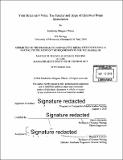| dc.contributor.advisor | Marcia Bartusiak. | en_US |
| dc.contributor.author | Phares, Madeleine Margaux | en_US |
| dc.contributor.other | Massachusetts Institute of Technology. Graduate Program in Science Writing. | en_US |
| dc.date.accessioned | 2017-01-30T19:17:12Z | |
| dc.date.available | 2017-01-30T19:17:12Z | |
| dc.date.copyright | 2016 | en_US |
| dc.date.issued | 2016 | en_US |
| dc.identifier.uri | http://hdl.handle.net/1721.1/106762 | |
| dc.description | Thesis: S.M. in Science Writing, Massachusetts Institute of Technology, Department of Humanities, Graduate Program in Science Writing, 2016. | en_US |
| dc.description | Cataloged from PDF version of thesis. | en_US |
| dc.description | Includes bibliographical references (pages 24-26). | en_US |
| dc.description.abstract | The potential of electricity to improve the brain has captivated many. Electrical gadgets attract the rich and the poor, the educated and uneducated, the scientist and the charlatan. Over hundreds of years, people have tried everything from shocking away headaches with live torpedo fish, to bombarding patients' brains with so much current that their bodies convulse. A more innocuous technology has since emerged: transcranial direct current stimulation, or tDCS. All it takes to build is a small battery, two wires, two electrodes, and salt water. The idea is that by priming the brain with a mild electrical current, an incoming stimulus would be easier to process. In other words: less mental effort to learn something new, like recovering from a stroke or improving ski jump performance. Three primary communities are interested in tDCS today: do-it-yourselfers, clinical researchers, and neurotechnology companies. They want it for different reasons, and yet they are still wary of one another. But tDCS, in all of its simplicity, is actually not so simple-and neither is the human brain. What makes it so appealing to so many people of so many different backgrounds? How does it work? And does it deliver? | en_US |
| dc.description.statementofresponsibility | by Madeleine Margaux Phares. | en_US |
| dc.format.extent | 24 pages | en_US |
| dc.language.iso | eng | en_US |
| dc.publisher | Massachusetts Institute of Technology | en_US |
| dc.rights | MIT theses are protected by copyright. They may be viewed, downloaded, or printed from this source but further reproduction or distribution in any format is prohibited without written permission. | en_US |
| dc.rights.uri | http://dspace.mit.edu/handle/1721.1/7582 | en_US |
| dc.subject | Graduate Program in Science Writing. | en_US |
| dc.title | Your brain on 9 volts : the specter and hype of electrical brain stimulation | en_US |
| dc.type | Thesis | en_US |
| dc.description.degree | S.M. in Science Writing | en_US |
| dc.contributor.department | Massachusetts Institute of Technology. Graduate Program in Science Writing | en_US |
| dc.contributor.department | MIT Program in Writing & Humanistic Studies | |
| dc.identifier.oclc | 969769087 | en_US |
